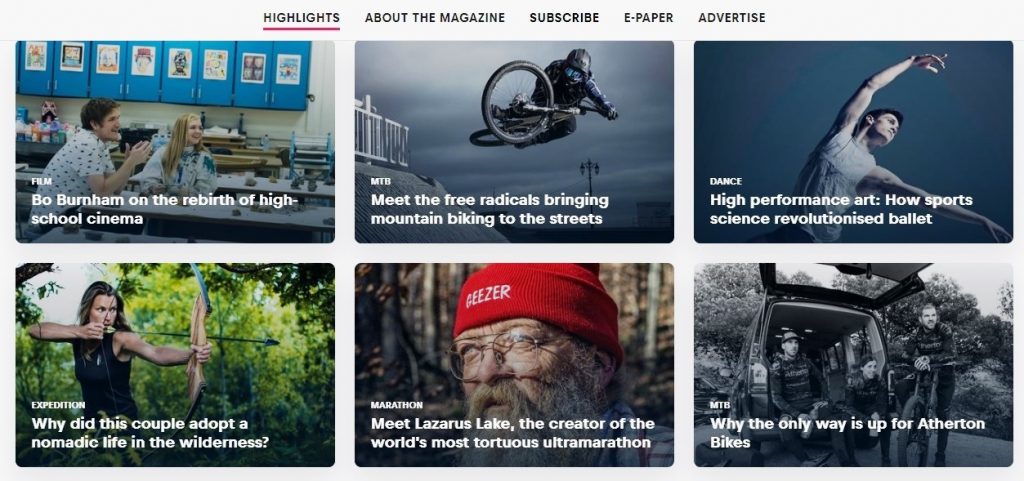
Image source: Red Bull
Outdoor gear retailer REI recently announced plans to launch a print magazine this fall. The print publication, Uncommon Path, will promote outdoor lifestyles with in-depth storytelling.
“Uncommon Path tells the stories of the experiences, events, issues and ideas that shape the relationship between people and life outside,” Ben Steele, executive vice president and chief customer officer for REI Co-op, stated in the company blog. “But those stories aren’t limited to trails and peaks. They take us to parks and urban places closer to home, covering issues like climate change impacts that, due to dwindling resources and shrinking local newsrooms, are inevitably getting less press.”
A team of in-house journalists will produce the magazine that will be available at REI stores and select newsstands. The first issue will describe a bike ride through Atlanta with Civil Bikes founder Nedra Deadwyler, reveal the stark landscape of the United States-Mexico border and explore what’s next for outdoor preschools. Naturally, the magazine will also mention REI’s favorite outdoor gear.
At the same time, REI will retire its mail-order catalog.
Advantages of Publishing Your Own Magazine
The magazine is part of an emerging trend of brand magazines — companies and sometimes nonprofit organizations publishing their own print magazines. Marketers find that print publications allow them to build brand loyalty and stand out in today’s crowded field of digital content, points out Nicolette Beard at TopRank Marketing.
Still, the strategy isn’t appropriate for all bands. Costs can be high compared to some digital marketing tactics. Determining ROI can be difficult, as non-paid circulation offers the only metric, and management buy-in may be difficult to secure. A company can produce a magazine for the cost of a full-page ad in a major consumer publication.
Some first-class brand magazines include Red Bull’s Red Bulletin magazine for extreme sports and adrenaline junkies, global fashion brand Benetton’s Colors magazine for the fashion-lovers and online retailer Net-a-Porter’s Porter magazine.
Some brands produce fascinating content and striking visuals on subjects that most people would consider boring, notes Piet van Niekerk at FIPP. ThinkMoney magazine, published by brokerage firm TD Ameritrade, serves options traders and has won several media awards over the years.

Image source: TD Ameritrade
ARC Magazine, produced by Lincoln Electric, the American multinational global manufacturer of welding products, serves the metal-forming and metal-fabricating community with entertaining and educational content. It was named Best New Print Publication at the Content Marketing Institute’s Content Marketing Awards. Brand magazines have a long tradition.
While brand publications appear to be multiplying, they have a long history. Content marketers typically cite The Furrow, first published by John Deere in 1912, as the prime example of a brand magazine. The Furrow initially bragged about John Deere’s equipment, but the company soon realized the value of emphasizing its customers – in this case farmers — rather than thinly veiled advertisements.
Tips to Creating Brand Magazines
Act like journalists. Follow the tenets of brand journalism. Develop style guidelines and an editorial calendar and hold regular editorial meetings. Spend time on research and analysis to uncover new angles on an existing subject, and cite authoritative experts and documented facts.
Focus on people. Stress the audience – whether farmers or options traders – and their challenges and their solutions. Even the most technical subject needs a human story behind it.
Define the tone. Writing examples can help guide new writers and editors.
Keep visuals consistent. The visual content should reflect the brand. That includes fonts, color, and layout.
Guard against drift. Establish a governance process that identifies who is responsible for keeping content up to date and aligned with the brand to guard against brand “drift” as creative teams explore fresh ideas.
Create a review system. Implement a system that enables all content be submitted electronically and reviewed by the brand team as they are created.
Track actions with CTAs. Ensure that every print page includes a call to action, such as a unique 800- number or distinct URL to track behavior from your magazine.
Promote it. Promote the publication on social media and the company website and with industry influencers, bloggers and the media.
Bottom Line: Many organizations reach their audiences, build brand loyalty and ultimately promote their products or causes with brand magazines. The key is high-quality visuals and superb writing and storytelling that meet the needs of the brand’s specific audience.
William J. Comcowich founded and served as CEO of CyberAlert LLC, the predecessor of Glean.info. He is currently serving as Interim CEO and member of the Board of Directors. Glean.info provides customized media monitoring, media measurement and analytics solutions across all types of traditional and social media.




